MENTAL ILLNESS – THE LEADING CAUSE OF SICKNESS ABSENCE AND LONG-TERM WORK INCAPACITY IN THE DEVELOPED WORLD
This is Part 2 in a 3-part series for Directors on their role in the boardroom to govern and lead mentally healthy workplaces.
In Part 1 of this 3-part series, #8 Investing in Mental Health is a Healthy Investment: ROI, I provided an overview of ‘what is mental health’ and the importance of acknowledging it as a positive concept (i.e. our mental health exists on a continuum from positive, healthy functioning at one end through to severe symptoms of mental ill-health at the other. A person’s mental health moves back and forth along this range during their lifetime, in response to different stressors and circumstances).
In this series I look at:
- What is mental health, and how can investing in protecting, promoting and supporting it contribute to your bottom line?
- How can the board govern mentally healthy workplaces?
- How can the board have a positive impact on the mental health of the business, via their relationship with the CEO?
As always, this post aims to assist you in knowing What to Ask and When to Act.
WHY BUSINESS LEADERS SHOULD READ THIS POST
In a survey conducted by the UK Institute of Directors (IoD), it was found that an overwhelming number of members who responded to the survey rrecognised that good mental health is crucial for their business:
- More than 80% believed good workplace mental health is very important – fewer than one per cent believed it is unimportant.
- They recognised the consequences are significant, with poor quality of work, poor decision making, conflict between colleagues and higher staff turnover all cited as negative outcomes as a result of poor mental health within an organisation.
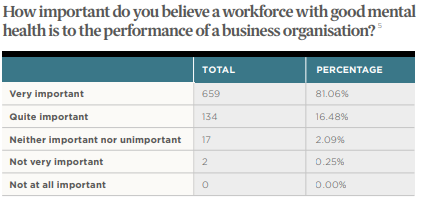
Institute of Directors, UK
However, it can be difficult to know everything that needs to be covered in order to lead a mentally healthy workplace from the boardroom. There is a vast amount of information available to you and no doubt you continually hear about the importance of mental health and the significant impacts of mental ill-health on your workforce and community.
This can make it difficult to filter through all the noise and clearly understand what the board can do from a governance and leadership perspective.
Therefore, this post is focused on extracting the three areas you should focus on when you’re defining what a mentally healthy workplace looks like: protection, promotion and support.
Simply put, your efforts into providing a mentally healthy workplace should fall within three categories: Plan-Protect-Support @beyondblue and Heads UpClick To TweetKNOWING IS NOT ENOUGH
While the IoD survey indicated there is no doubt that their members know mental health is important to their business, the survey also found that more needs to be done to ensure that mental health policies and procedures are embedded across organisations.
When asked whether members offer mental health training for management, a surprising four in five did not.
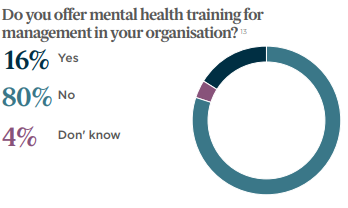 Institute of Directors, UK
Institute of Directors, UK
“Simply put – that needs to change. In those firms with board structures, mental health must be put higher up the agenda” – Institute of Directors, UK
A 2016 Managing Mental Health in the Workplace survey, conducted by the Australian arm of employment lawyers MinterEllison, found that only 38% of respondents have discussed staff mental health issues even once at the board level.
The survey also suggested that a majority of organisations are making little or no investment in mental health and wellbeing programs even though these can have a dramatic effect on the bottom line (see my first post in this 3-part series #8 Investing in Mental Health is a Healthy Investment – Part 1: ROI).
Furthermore, at a 2016 event hosted by the Australian Institute of Company Directors (AICD) on mental health, the Chairman of the Black Dog Institute, Peter Joseph AM FAICD, stated that business leaders appeared to have an over-optimistic view of their contribution:
“We were involved in research where 81% of business leaders said their workplace has one or more policies, procedures or practices in place to support mental health, but over a third of employees either did not know these resources existed or did not have access to them” – Chairman of the Black Dog Institute, Peter Joseph AM FAICD
He proposed that business leaders get a better understanding of the nature of the problem and communicate and implement what is required.
In a survey conducted in 2017 by SuperFriend, of 5000 people, from business owners, managers and employees in small, medium and large organisations from different industries across Australia, it was found that 1 in 2 workers were not aware of any workplace mental health and wellbeing policies in place at their workplace.
Additionally, only 1 in 6 workers believed the mental and wellbeing policies at their workplace were being implemented effectively.
“Organisational leaders play a critical role in driving policies and practices that promote mental health. They are able to positively influence workplace culture, management practices and the experience of employees” – SuperFriend
Plan – Protect – Support
As outlined by Heads Up and beyondblue, your approach to mental health should be focussed in three areas: promotion, protection, and support. Simply put, your efforts into providing a mentally healthy workplace should fall under these three categories.
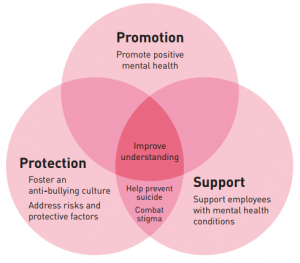
Heads Up and beyondblue
4-PART FRAMEWORK FOR LEADING WORKPLACE MENTAL HEALTH GOVERNANCE IN THE BOARDROOM
We know the overarching responsibility of the board is the overall governance, management and strategic direction of the organisation, but what does this look like when applying this workplace mental health?
I’ve taken the Plan-Protect-Support model and applied it to my 4-part framework for directors in applying health & safety governance and leadership in the boardroom. In doing so, I’ve curated a selection of research on better practice approaches to establishing and maintaining a mentally healthy workplace that will assist you in leading the governance of mental health in the boardroom.
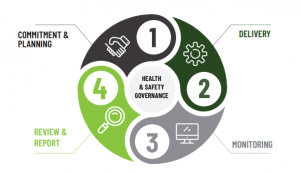
SM Safety Solutions
1. COMMITMENT & PLANNING
- Establish a governance structure to facilitate the effective integration and development of a workplace mental health strategy. For example, appoint a non-executive director or establish a sub-committee to work with the executive team to ensure mental health openness is culturally installed across an organisation and to ensure that cultural change is led from the top. Ensure the non-executive director or sub-committee have clear reporting duties and responsibilities
- Include ‘mental health’ is added as a standing point on board meeting agendas. Actively make clear that in your business, talking about mental ill-health is as normal as talking about the accounts. Change the conversation to promote mental health as a positive concept, rather than framing it in negative terms
- Increase trust in the organisation (see my post #7 How to Leverage Workplace Health & Safety in Your Organisation to Build Trust) so that mental ill-health is discussed, reported on, and addressed in the same way physical injuries are
- Ensure a zero-tolerance approach to bullying
- Consider establishing a steering committee that includes senior management and strategic areas of the organisation (i.e. HR, communications and training as well as senior managers/executives overseeing operational areas of the workplace). The steering committee will be most effective if it’s lead by an executive sponsor who will report back to the executive and have a key role in regularly communicating to all staff that mental health and wellbeing is a priority. For this role, consideration should be given to people who are respected by staff and who contribute positively to the workplace culture
- Promote the business case for investing in mental health and that addressing psycho-social risk is best practice from an organisational performance perspective
- Acknowledge work design as a priority, and authentically acknowledge its contribution to psycho-social risk
- Explain the ROI for implementing effective strategies and foster commitment to addressing mental health at an individual and organisational level
- Develop a strategy for mental health that is aligned to evidence-based approaches and includes goals and objectives, including inputs required – such as financial resources, time or additional staffing. Ensure your broader goals cover the three primary areas of promotion, protection, and support. This includes improving job design, enhancing personal and organisational resilience, supporting early help-seeking and workers’ recovery. Areas should be identified to maximise protective factors and minimise risk factors
- Ensure your strategy is backed by a robust situational analysis. The situational analysis will assist in determining where you are now, and where you need to go – the strategy. The analysis should review internal and external information including looking at your policies, programs, support structure and practices for different groups of staff – particularly if these are different across various geographical sites, and identifying underlying issues in your workplace
- Ensure your indicators will assist in measuring your ROI and improvement.
- Discuss the necessary resources required to deliver the strategy
- Develop and implement policies such as a mental health and wellbeing policy, bullying & harassment policy
- Acknowledge that mental health is a long-term investment and success requires ongoing effort to be sustained permanently
- Have regular conversations with the CEO on their personal mental health and wellbeing – this signals the importance of mental health and encourages your CEO to have similar conversations with their team
- Consider the provision of tailored in-house mental health support and signposting to clinical health, including digital support, employer-purchased occupational health or employee assistance programs
2. DELIVERY
- Ensure training is delivered to the board, management and the workforce to provide:
- a basic understanding of mental health and wellbeing
- awareness of what mental ill-health looks like and how to respond (i.e. how to respond to direct reports and colleagues)
- where to access the organisation’s policies, procedures, support structures and systems for dealing with mental ill-health
- Regularly communicate the support systems in place for those who made need it
- Ensure the accessibility of tools, information and support to all workers and management (consider work groups such as those who conduct shift work, work remotely or outworkers)
- Ensure psycho-social risks are included in the corporate risk register
- Identify the need for collaborations / external expertise to deliver your mental health strategy
3. MONITOR
- Capture lead and lag indicators that will assist in measuring progress of the strategy. Ensure you understand the risk factors (identified in the situational analysis) so that you can identify appropriate indicators that should be included in your monitoring activities
- Analyse your data for trends, changes and gaps. Compare the data to original findings – what’s changed and by how much?
- Leverage new technologies to capture information on psycho-social risk in a timely manner
- Watch for challenges in implementing the strategy, such as not meeting timeframe, to understand causes (i.e. is this because there are insufficient resources? Do people understand how they can contribute to implementation? Do people know about the resources? Are management involved or is implementation sidelined to HR or health & safety teams? Are the timeframes realistic?)
- Monitor the psycho-social safety climate (PSC), as PSC provides early indications of risks for poor psychological health outcomes — establish PSC as an organisational key performance indicator
4. REVIEW & REPORT
- A review is useful every 12 – 18 months. Consider how the timing of your review aligns with your organisation’s evaluation and development of broader organisational and workplace health & safety strategies. This will help ensure mental health and wellbeing are part of our organisation’s business as usual
- Compare data before and after the implementation to inform decision-making for future mental health and business planning
- Acknowledge what is working and what isn’t. Common challenges include resistance from stakeholders, limited resources, cost, stigma, lack of interest or participation, or fear of addressing or disclosing mental health issues and consequences
- Be transparent in reporting when things don’t go as well as expected. Honesty and transparency will build trust and the goodwill of staff
- Review the disclosure process to encourage openness during recruitment and throughout, ensuring employees are aware of why the information is needed and make sure the right support is in place to facilitate a good employer response
- Review the disclosure process for transparency and conflicts of interest
- Ensure the assurance framework is appropriate to identify how the organisation’s activities (e.g. job design, systems of work) are associated with psycho-social risks
- Seek employee feedback on implementation of the strategy
- Be open to amending the strategy where needed.
Now it’s your turn:
What does your board do to lead governance of mental health?
Leave a comment below and let me know.
Remember, share as much detail as possible in your reply. Your story and/or thoughts may lead to someone’s meaningful breakthrough and it all contributes to this audience knowing What to Ask, and When to Act #knowWTA
Important: share your thoughts and ideas directly in the comments. Links to other posts, videos, etc. will be removed.
Thank you so much for adding your perspective to the conversation!
Thanks for reading!
Welcome!
I’m Samantha
I teach board members and executives how to lead with heart and put people first, by leading safe & healthy work. Stick around and I’ll share with you the skills, knowledge and mindset you need to know what to ask, and when to act and lead with confidence.
RESOURCES
YOU MAY ALSO LIKE…
FEATURED CONTENT
[text-blocks id=”4249″ plain=”1″]





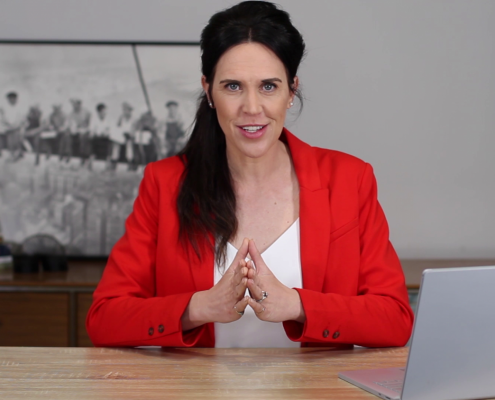


Let us know what you have to say:
Want to join the discussion?Your email address will not be published.